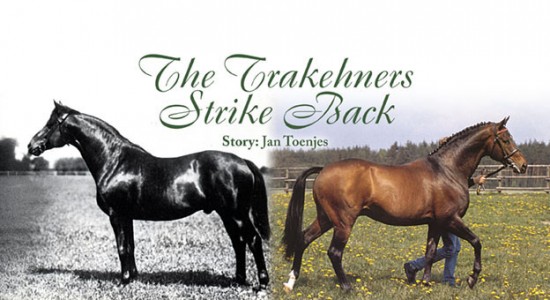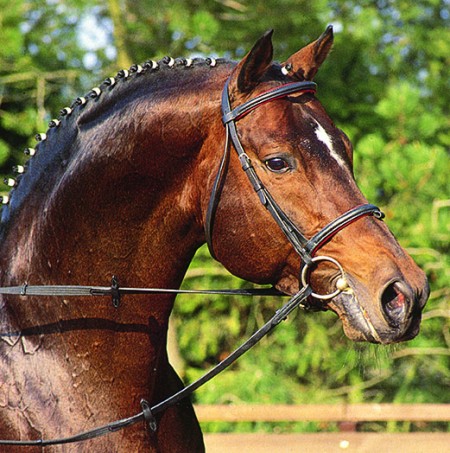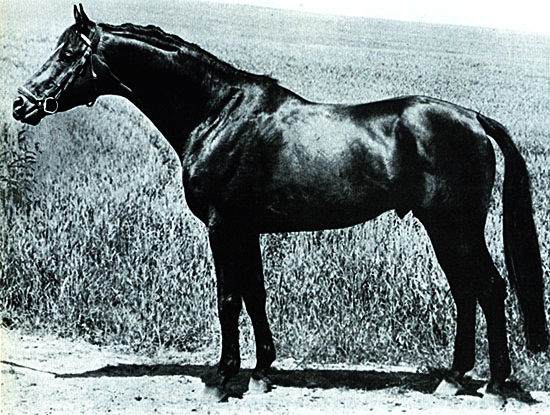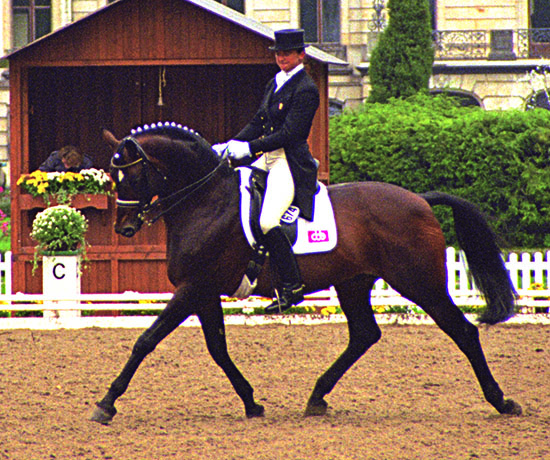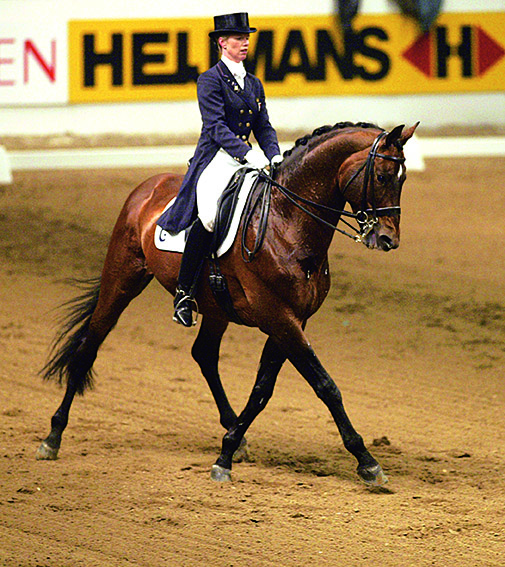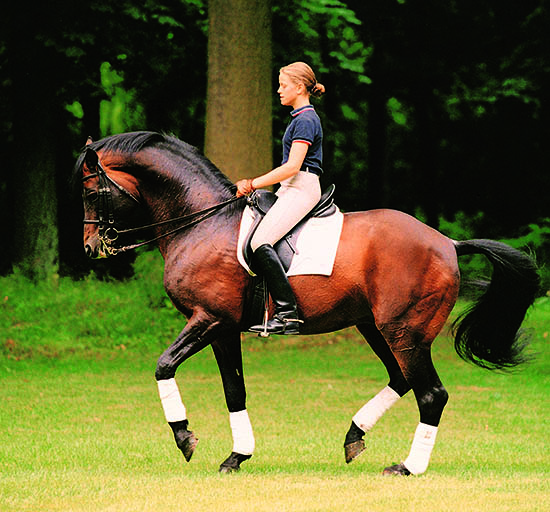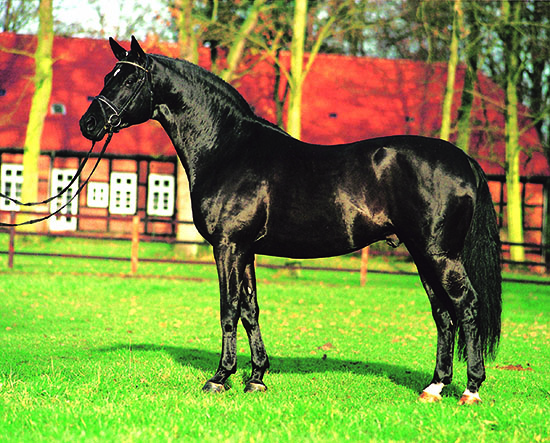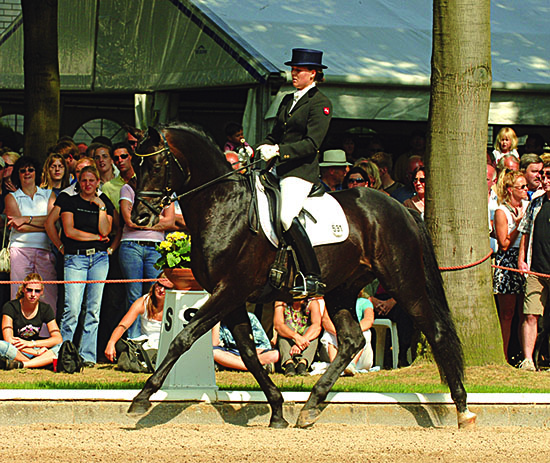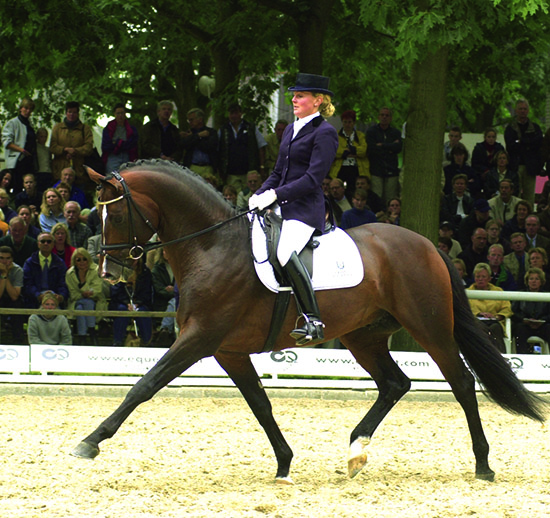Above Left: Pythagorus, born in Trakehnen in 1927, would have been the most important stallion ever used at the stud, but evacuation in 1944 put a premature end to his career, and right, Arogno, the ‘picture perfect example of a modern horse’…
Our German breeding expert, Jan Töenjes concludes his series of articles on the revival of the Trakehner breed in Germany.
Ask a horse person for a Trakehner stallion that produces horses with very good rideability, without the certain Trakehner type so often requested by horse lovers. The answer will most likely be Caprimond or his son Hohenstein or his grandson, Muenchhausen. If there is a still flourishing sireline in modern Trakehner breeding then it is the one founded by Arogno who was born only 30 years ago. Himself the picture perfect example for a modern horse, the Trakehner society should raise money to build a monument for this outstanding stallion, thinks Jan Toenjes and that’s why he is concentrating in his final part on the modern Trakehner breeding on the progeny of this legendary sire.
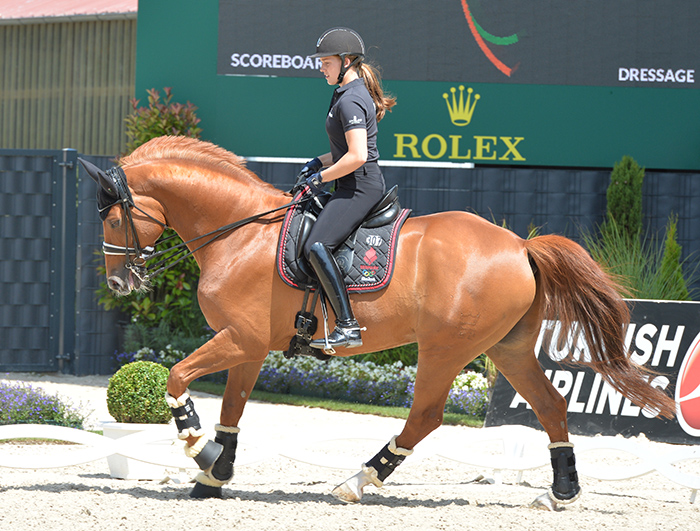
Cassidy, the Caprimond son who brought Cathrine Dufour to international fame…
Talking about Trakehner is talking history. The old breeders will always refer to the good old times in East Prussia. Names like Dampfross or Pythagoras are being dropped as if these heroes of the first half of the 20th century were still alive. But the by far most influential sire in post WW2 times was Arogno. Not a product of one of the often praised damlines from the Trakehnen main stud (who actually did not walk all the way from East Prussia to Germany, like so many other mares, but were moved by train to safe areas in Western Germany when it became apparent/obvious that the Russians would sooner or later conquer East Prussia).
Arogno…
Arogno a bay stallion standing at 16.2 hands with a picture perfect conformation and a beautiful face was a halfbred. His dam Arcticonius was an Irish Thoroughbred inbred to Nearco. She was imported to Germany and entered into the Trakehner main marebook. Later she recieved elite status. As a producer she was probably the best Thoroughbred mare ever to be used in a German Warmblood breeding programme.
Arcticonius gave birth to three graded stallions, Avignon (sold to the U.S.) and Arogno, both by Flaneur and Acajou by Flaneur’s son Damaskus. Her daughters Anna Karenina and Arktis also produced graded stallions. Anna Karenina’s Matcho son Amatcho sired Miss Meller TSF one of Germany’s most successfull eventers ridden by former double European young riders champion, Michael Jung who in 2005 won the first two trials for the European Championships beating several Olympians.
Arogno’s sire Flaneur was runner up at the grading 1968. His sireline (Maharadscha by Famulus by Fetysz ox) is based on the Arab Fetysz. Maybe this is what makes him so special. One last thing needs to be pointed out – to complete the confusion: Maharadscha’s dam Marke is also very influential as foundation mare of her own damline that produced sires such as Mahagoni, Matador (Hohenstein’s grandsire) or Mackensen.
But enough of all this line breeding theory. The simple fact to remember is that Arogno carries a lot of Thoroughbred plus a dash of Arabian bloodlines added to one of the most remarkable dams of the Trakehner breed.
This is the Trakehner stallion, Flaneur, the sire of Arogno but this is not the Holstein stallion of that name who was imported to Australia.
It wasn’t only the excellent conformation and his pretty head that helped Arogno to win the Reserve Champion Stallion at his grading in Neumuenster. It was his movement and his rideability. As a 3-year-old he was reserve at one of the first Bundeschampionate and finished his stallion performance test in Adelheidsdorf as the best Trakehner stallion to be examined that year.
Today Arogno would probably belong to the top stallions of which dozens of doses of semen would be collected to be sent out worldwide. In 1979 it was different. Arogno was popular but only among Trakehner breeders and it took a while until his breeding career started to become really successfull. Arogno often changed his stud. He served at his breeder’s farm and at traditional Trakehner stud’s like Webelsgrund and Haemelschenburg. In his later years, Arogno stood at the Amselhof Walle, built by Joachim Kemmer for his daughter Heike.
By far the most successful offspring was TCN Partout out of Pedola by Donauwind (Abdullah’s sire). Purchased at the Trakehner grading 1989 by several Dutch Trakehner enthusiasts and brought to Anky van Grunsven who took Partout on to an international career. He was Dutch champion in the small tour, two times 2nd in the Dutch Grand Prix championships only beaten by Bonfire, won several Grand Prix specials and claimed the victory at the World Cup qualifier in Amsterdam. He was also named Anky’s reserve horse for the 1996 Olympic Games in Atlanta.
In breeding he was equally successful: His son Monteverdi was champion stallion at the Trakehner grading and already has international placings under the Danish rider, Fie Skarsoe from Wiesenhof stud in Germany. Monteverdi himself sired Oliver Twist who himself looks not really like a typical Trakehner but according to the evaluation board produces lovely offspring.
Another son, Halbgott, is successful in the U.S. with placings at several shows of the prestigious winter circuit in Florida. A couple of mares by Partout won breeding shows in Holland.
The international performer who was a sensation in Denmark – Schwadroneur with World Champion Anne-Grethe Törnblad in the saddle
It seems the best offspring of Arogno sooner or later left Germany, like Schwadroneur, born in 1983 by Arogno out of Schwalbenburg (another producer of four garded sons) by Ibikus. Schwadroneur was reserve champion at the stallion performance test and made his career in Denmark. Ridden by Anne Grethe Törnblad (born Jensen, famous for riding Marzog in the 1980s) Schwadroneur had 36 wins up to Grand Prix Special. In the 1990s Danish dressage breeding had only one name: Schwadroneur. He sired and incredible number of sporthorses, champion mares and graded stallions.
German sport statistics list an index of 151 in 2003 – a top score that gives him a place somewhere up there amongst Weltmeyer, Rubinstein and Donnerhall. In 2000 and 2001 he had the top priced mares at the International Trakehner Stallion Market, Tamara was sold for 140.000 deutschmarks, Evita for 110.000 deutschmarks. In 2000 he was named Danish stallion of the Year and also Trakehner Stallion of the Year in Germany. Esprit by Schwadroneur and Nicole Ahlefeld were 10th in the world ranking dressage.
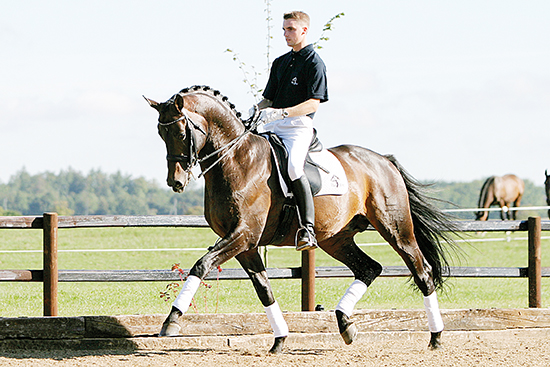
Hertug and Andreas Helgstrand
His best son is Hertug, like Partout out of a Donauwind mare. As a young horse Hertug won everything a horse can win in Denmark. Three years in a row he was unbeaten at the young horses championships. Later he won PSG and Inter I ridden by Andreas Helgstrand. In 2005 Blue Hors stud sold Hertug, whose charming appearance can be compared to George Clooney’s – women simply die if they could touch him once. Well, Clooney has the Oscar, Hertug hasn’t yet. But his promising offspring is still young and so far it seems they are well aware of the reputation of their sire’s family. He is also approved for Sweden and Oldenburg.
Partout – A reasonable international performer for Anky van Grunsven, and then a respectable breeding stallion
It seems that success at Prix St Georges level is the least thing an Arogno-offspring wins. Many of his graded sons were successful in the small tour, and a lot of them also performed all the Grand Prix movements. Rideability and trainability has become a synonym for Arogno’s offspring.
Before focusing on the biggest and most successful branch of Arogno’s line, the one based on Caprimond, just some brief notes on Arogno’s son Ivernel. This leggy chestnut was top priced horse at the Trakehner auction at the Klosterhof Medingen stud where he later performed a very good stallion performance test. It was Petra Wilm, member of the German B squad and heir of a big company who fell in love with the chestnut.
Ivernel proved to be a super sensitive horse who though trained to FEI level was unable to concentrate throughout an entire test in the dressage ring. His offspring however showed typical Arogno qualities. His son Pret à Porter died as a 5-year-old but sired Le Rouge who in 2004 was awarded Trakehner champion stallion in Neumuenster and was in the finals of the 2005 bundeschampionate.
In 2005 it was Arogno again. Herzensdieb (i.e. thief of hearts) by Tambour, was everybody’s darling right from the beginning and the Trakehner grading board agreed with the audience and named Herzensdieb Trakehner champion stallion 2005. Arogno can be found in Herzensdieb’s fifth generation. When the wooden hammer of Germany’s top auctioneer Uwe Heckmann knocked down the young stallion at the price of 275.000 Euro, the historic Holstenhallen-indoor arena almost collapsed. Never before was a champion stallion sold for such a high price.
It was the American couple Douglas and Louise Leatherdale who were willing to pay that much money for the champion. The also bought the Hannoverian champion stallion His Highness a couple of years ago for 515.000 Euro which turned the entire horse community in Germany wild. Both stallions, His Highness (by Hohenstein) and Herzensdieb (by Tambour), found their new home at Jens Meyer’s stud station in the small village of Dorum close to the North Sea coast. Both can be traced back to Caprimond, an Arogno grandson that many think of the picture perfect example of a beautiful horse.
Caprimond – a modern Pythagoras
The crowd went berserk when Lars Gehrmann, breeding director of the Trakehners, at the 2005 gala show of the International Trakehner Stallion Market named Caprimond ‚the Pythagoras of today’. To compare a stallion to legendary Pythagoras is like comparing a contemporary scientist to Albert Einstein, a musician to Leonard Bernstein or a composer to Mozart. Pythagoras sired the unbelievable number of 70 graded stallions in only 13 years. And that was between 1932 and 1945.
WW II ended Pythagoras life but his name has got a somewhat magic touch ever since then. Gehrmann for sure knew about the meaning of this comparison but he also knew how much Caprimond has improved the Trakehners’ image in all Warmblood breeds in Germany. Up to today his name is to be found in one of the first three generations of 52 graded stallions! And in sports he was still going strong! As a 19 year old he was still in the ribbons in Grand Prix shown by his owner Burkhard Wahler’s eldest daughter, 17-year-old Theresa Wahler.
Far and away the most popular Trakehner stallion in Hanover – Hohenstein. Grand prix performer, and super sire.
Caprimond and Hohenstein
Caprimond’s career started in 1987 when he was runner up at the Trakehner grading beaten only by Kostolany, Gribaldi’s sire. Caprimond was also chosen best type stallion. As a three year old he was 2nd at the Bundeschampionat and did an oustanding stallion performance test with high scores in rideability. For his entire career Caprimond stayed at the Klosterhof Medingen stud an hour drive south of Hamburg. As a 10-year-old he recieved the elite stallion status as the youngest sire ever to be awarded with this title.
In 2002 Theresa Wahler, then only 14 years old, won her first PSG on Caprimond. The stallion always impresses people when he is presented by the Wahler’s children: 10-year-old Christoph, who, like his father Burkhard a former German eventing champion is more into 3-day-eventing, rode Caprimond at several stallion shows and showed all the Grand Prix movements, even a piaffe pirouette. The classical like father like son situation was even stressed by the fact that Burkhard Wahler accompanied his youngest son riding Hohenstein, Caprimond’s most successful son so far and sire of His Highness and grandsire of Herzensdieb.
Caprimond’s official retirement from sports is scheduled for August 28 when the big stallion parade will take place at the WEG in Aachen. His influence on his home breed is constantly rising: In 2003 18 per cent of all stallions presented at the Trakehner grading carried Caprimond, in 2005 it was almost a third (32.7 per cent). In 1994 the Wahler’s mare family of Donauquelle (all by Caprimond) won the German mare championship.
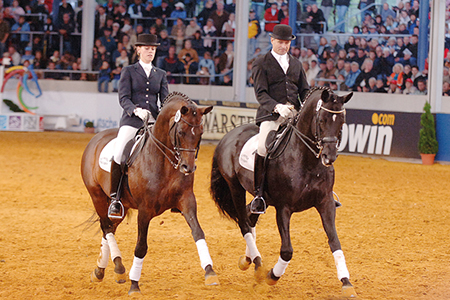
Caprimond and Therese Wahler and Hohenstein and Burkhard Wahler
In the past decade Caprimond and Hohenstein were always among the tops in the statistics of the Hannoverian association. They often stood in front when it came to the aspects riding horse type and rideability. Caprimond’s Hannoverian son Contucci (out of a Lungau mare) is very popular in the USA.
Several graded Hannoverians have Caprimond dams, the top example is Dacaprio by Davignon.
Hohenstein, like his sire, is trained to Grand Prix and a winner at Prix St Georges, is considered one of the best dam producers in Hannover. His sons His Highness, who qualified for the Bundeschampionate in 2005, is a promising FEI horse says US dressage coach Klaus Balkenhol who has kept an eye on the huge black stallion ever since his spectacular win at the Hannoverian stallion grading of 2002.
Another almost black son of Hohenstein, Insterburg out of Indira by Giorgio Armani (by Arogno!), was third at the 2005 World Championships of Young Dressage horses and the Bundeschampionate ridden by Carola Koppelmann. Experts think the combination has a big potential for an international career. And then there is Münchhausen.
Putting Trakehners on the map at the Bundeschampionate – Insterburg and Carola Koppelmann
Danish Dynamo!
Danish dressage star, Fie Skarsoe is the rider of Münchhausen. This Hohenstein son has had a dream of a career. Champion stallion at his grading, super stallion performance test, runner up at the World Championships of Young Dressage horses in Verden beaten by Karin Rehbein and Cherie FRH. Two years later he performed at the Nuernberger Burgpokal championships – the unofficial German championships for FEI prospects. Finally in 2005 Muenchhausen was chosen for the Danish team at the European Championships in Hagen a.T.W. and in Aachen he was placed – in the consolation finals.
Stars at the Bundeschamp, now starring at Grand Prix – Münchausen and Fie Skarsoe
The gorgeous bay is now supposed to concentrate on the sport. Breeders may only use frozen semen. Three sons are graded, two out of Thoroughbred mares, Sambataenzer and Meraldik. The latter out of a full sister to Heraldik, one of the most influential Thoroughbreds in Germany in the past 15 years. A couple of excellent mares put emphasis on the fact that Münchhausen is fitting well into the scheme laid out by his legendary ancestor, Arogno.
Same is true for Herzensdieb’s sire Tambour by Hohenstein out of a mare by Consul. Again rideability is the point of interest.
No matter in what direction Germany’s breeding policy may go, one thing is for sure: The Trakehner horse is here to stay. Within all the other breeds Trakehners are gaining more respect than say, 15 years ago. With performance, not beauty being the emphasis, the Trakehner horse has managed to improve its reputation and the number of breeders thinking about using a Trakehner stallion or at least one carrying the famous bloodlines from East Prussia, is increasing. The way back to the top where the Trakehner once was may be long but the direction is clear. So here you go, Trakehner horse!
This article originally appeared in the May 2006 edition of The Horse Magazine
Trakehners starring at the 2022 World Dressage Championships…

One of the stars – Hermès is by the all-Trakehner bred Easy Game, he’s by Gribaldi (Kostolany (Enrico Caruso (Falke/ Ibikus) out of a Schwadroneur (Arogno / Ibikus) mare.
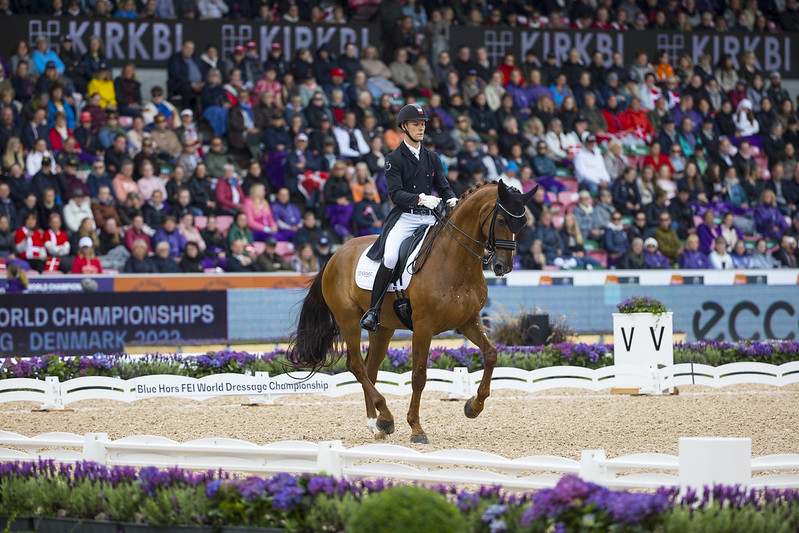
Daniel Bachmann’s Marshall-Bell is by Blue Hors Don Romantic (Don Schufro / Romancier) is out of a mare by Michellino by the Trakehner Michelangelo – there’s even a cross of Ibukus lurking on the bottom line…
And of couse, let’s not forget Dalera, soon to return to competition…
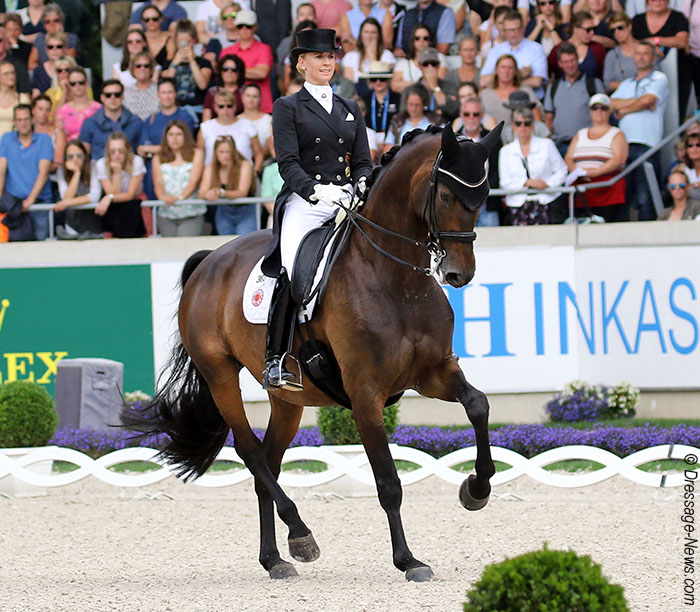
Dalera is by the Trakehner, Easy Game



